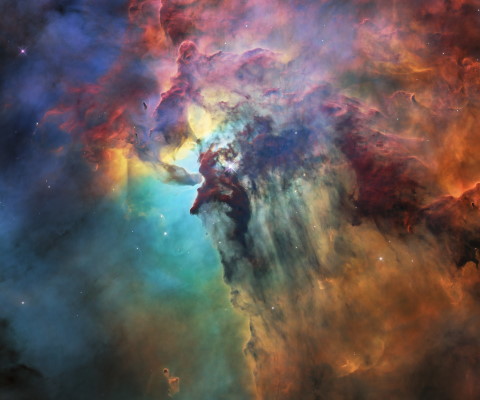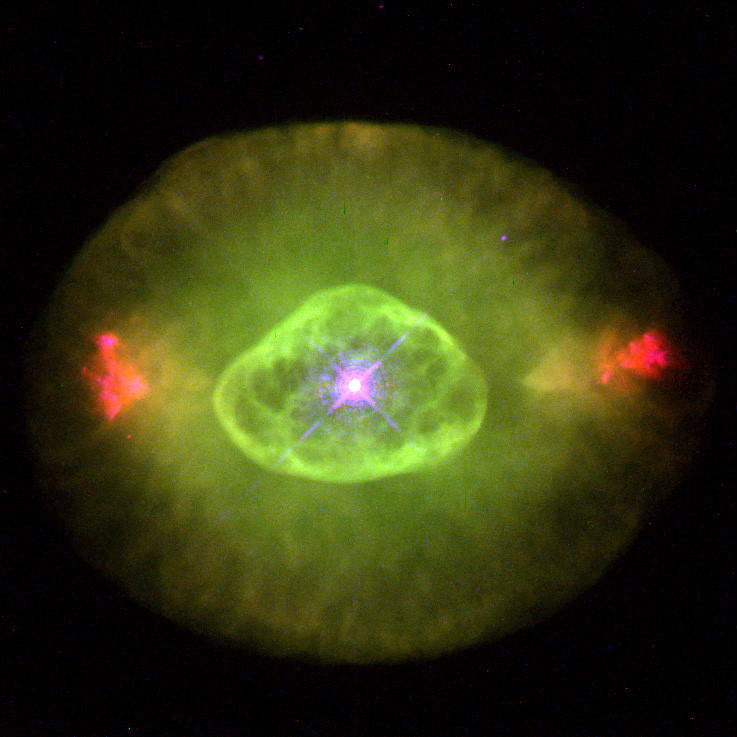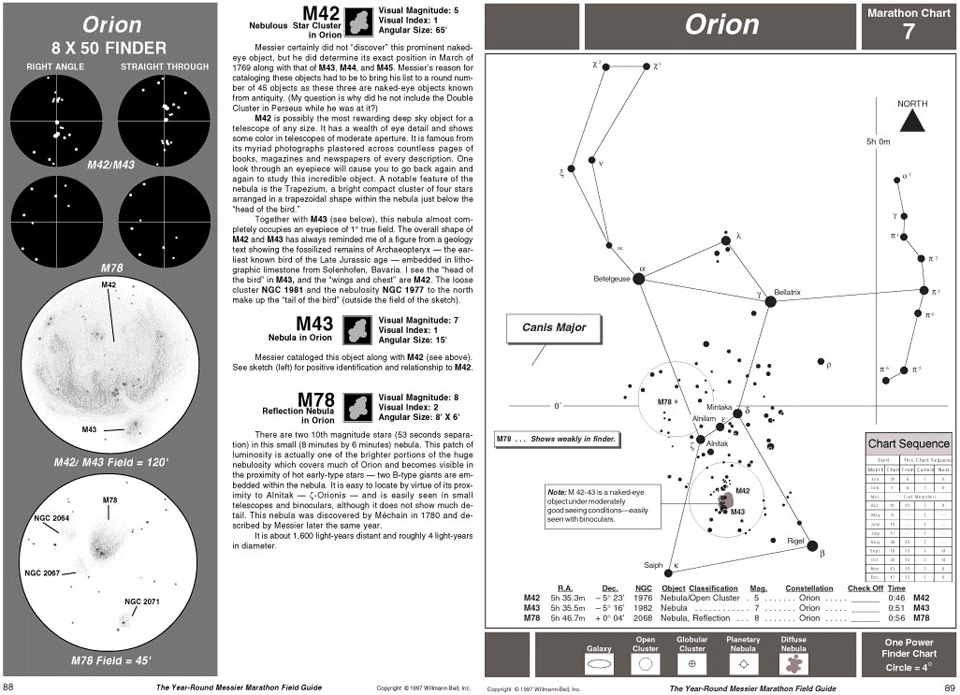Introduction
By no means complete, July's mini guide that follows provides notes for exploring various interesting deep sky objects (DSOs) and lists other items of interest useful to the amateur astronomer.
Entries can be interpreted based on designation, description and magnitude as follows.
Designation – Description – Magnitude:
★ Telescopes 10-inch aperture minimum.
★★ Telescopes 6-inch to 9-inch aperture.
★★★ Binoculars (50mm+ aperture) and telescopes
3-inch to 5-inch aperture.
A collimated instrument, favourable atmospheric conditions, dark skies and dark-adapted eyes are assumed.

M8 Lagoon nebula. Credit: NASA, ESA, STScI.
About M8 Lagoon nebula
To celebrate its 28th anniversary in space the NASA/ESA Hubble Space Telescope took this amazing and colourful image of the Lagoon Nebula. The whole nebula, about 4000 light-years away, is an incredible 55 light-years wide and 20 light-years tall. This image shows only a small part of this turbulent star-formation region, about four light-years across.
This stunning nebula was first catalogued in 1654 by the Italian astronomer Giovanni Battista Hodierna, who sought to record nebulous objects in the night sky so they would not be mistaken for comets. Since Hodierna’s observations, the Lagoon Nebula has been photographed and analysed by many telescopes and astronomers all over the world.
The observations were taken by Hubble’s Wide Field Camera 3 between 12 February and 18 February 2018.
Credit: NASA, ESA, STScI.
| July deep sky objects |
| Cygnus constellation |
|
NGC6826
|
The Blinking Nebula is better observed in a 6-inch to 8-inch instrument otherwise the bright the central star overwhelms the view. Large instruments will hint a blue/green hue.
|
8.80
|
★★
|
|
NGC7008
|
Planetary nebula with two bright stars close by, visible in an 8-inch instrument.
|
13.5
|
★
|
| Lyra constellation |
|
M56
|
Small round cluster. Visible in binoculars as a fuzzy star.
|
9.50
|
★★
|
|
M57
|
The Ring Nebula is a beautiful planetary nebula visible in a 4-inch instrument and takes magnification very well. Two 14th and 15th magnitude stars in its centre can be resolved with a 10-inch instrument under good conditions. Ideal for CCD imaging.
|
9.50
|
★★★
|
|
IC1296
|
Faint galaxy in the same field of view with the M57.
|
15.1
|
★
|
| Vulpecula constellation |
|
M27
|
The Dumbbell Nebula is the brightest nebula in the sky. It is visible in binoculars where it appears as a bright fuzzy patch. Medium size instruments will reveal its hourglass like shape. Larger instruments will show hints of colour and its central star.
|
7.5
|
★★★
|
|
NGC6885
|
Open cluster with around 30 members.
|
9.1
|
★★★
|
|
NGC6882
|
Open cluster in the same field of view with the NGC6885.
|
5.5
|
★★
|
| Delphinus constellation |
|
NGC6905
|
Planetary nebula visible in a moderate sized instrument.
|
12.0
|
★★
|
|
NGC7006
|
Globular cluster that can only be resolved in large instruments.
|
10.3
|
★★
|
|
NGC6934
|
Globular cluster visible in binoculars.
|
10.0
|
★★
|
| Scutum constellation |
|
M11
|
The Wild Duck cluster with around 3,000 stars. The cluster is easily visible in binoculars.
|
7.0
|
★★★
|
|
M26
|
An open cluster with around 25 members partially obscured by interstellar dust.
|
9.50
|
★★
|
|
NGC6664
|
Star cluster with around 40 stars.
|
8.9
|
★★
|
| Aquila constellation |
|
NGC6781
|
Planetary nebula visible in an 8-inch instrument that shows a bubble-like shape.
|
11.0
|
★
|
|
NGC6704
|
Open star cluster.
|
9.19
|
★★
|
| Sagittarius constellation |
|
M8
|
The Lagoon Nebula can be seen to the unaided eye under dark skies. Within its centre lies a star cluster made out of young stars that heat up the nebula’s gasses that in turn emit light. The dark lane that splits the nebula can be observed in large binoculars where larger instruments will show the nebula’s interesting structure.
|
5.0
|
★★
|
|
M17
|
The Omega Nebula engulfs around 30 stars in its mass where star formation is taking place. Visible to the unaided eye larger instruments will reveal considerable detail. Well suited for CCD imaging.
|
7.0
|
★★★
|
|
M20
|
The Trifid Nebula is a hot red emission nebula surrounded by a blue reflection nebular made of dust. Its 3 radial lanes that become apparent in moderate size instruments.
|
5.0
|
★★★
|
|
M22
|
Globular cluster with over half a million stars visible to the unaided eye that will resolve well in larger instruments.
|
6.5
|
★★★
|
|
M23
|
Open cluster with 100 members positioned in front an extensive gas and dust network.
|
6.0
|
★★★
|
|
M24
|
Better viewed in binoculars or in instruments under low powers the M24 is an exceptionally rich stellar region that also contains a Barnard Dark Nebula and a NGC6603 star cluster.
|
11.5
|
★★
|
|
M25
|
A loose open cluster of around 600 stars for binoculars and instruments under low powers.
|
4.9
|
★★★
|
|
M54
|
Globular cluster and a member of the Sagittarius Dwarf Galaxy. Very difficult to resolve.
|
8.5
|
★★
|
|
M55
|
Open cluster with a loose collection of stars that appears as a fuzzy star in binoculars.
|
7.0
|
★★★
|
|
NGC6530
|
Open cluster encompassed in the Lagoon Nebula.
|
4.59
|
★
|
|
NGC6603
|
Open cluster superimposed over a rich stellar region.
|
11.1
|
★★★
|
| Cerpens Cauda constellation |
|
NGC6611
|
Open cluster located in the same field of view with the M16.
|
6.0
|
★★★
|
|
|
Designation, Description, Magnitude
|
★ Telescopes 10-inch aperture minimum.
★★ Telescopes 6-inch to 9-inch aperture.
★★★ Binoculars (50mm+ aperture) and telescopes 3-inch to 5-inch aperture.
|
The night sky
Under excellent conditions over 2,000 stars can be seen with the unaided eye but only a few hundred of these are prominent enough to be useful in navigating the night sky, these are normally included in amateur sky maps and digital planetarium programs like the SkySafari, Stellarium, The Sky, Starry Night, Winstars 2 etc. Some stars will show colour that is useful in identifying them. For example, Antares, Betelgeuse and Aldebaran are orange/red where Vega, Rigel and Spica appear as blue/white.
Stars that form easily recognisable patterns have been given names and are referred to as constellations. Of these, the brightest stars act as beacons and can be used to effectively navigate the night sky during the different months of the year. To that extent stars can be particularly useful in locating other interesting objects nearby normally viewable through binoculars or larger instruments.
Planets and their satellites, comets and meteors move independent of the night sky background and at comparatively high speeds. They are therefore very difficult or impossible to reference to any star. However, planets like Jupiter, Saturn, Venus and Mars as well as the Moon are easy to spot with the unaided eye and in the case of the larger planets and especially the Moon, even medium size binoculars will reveal a limited degree of detail.
NGC 6826 planetary nebula
NGC 6826's eye-like appearance is marred by two sets of blood-red 'fliers' that lie horizontally across the image. The surrounding faint green 'white' of the eye is believed to be gas that made up almost half of the star's mass for most of its life. The hot remnant star (in the centre of the green oval) drives a fast wind into older material, forming a hot interior bubble which pushes the older gas ahead of it to form a bright rim. (The star is one of the brightest stars in any planetary.) NGC 6826 is 2, 200 light- years away in the constellation Cygnus. The Hubble telescope observation was taken Jan. 27, 1996 with the Wide Field and Planetary Camera 2.
Credit: Bruce Balick (University of Washington), Jason Alexander (University of Washington), Arsen Hajian (U.S. Naval Observatory), Yervant Terzian (Cornell University), Mario Perinotto (University of Florence, Italy), Patrizio Patriarchi (Arcetri Observatory, Italy) and NASA/ESA.

NGC 6826 planetary nebula. Credit: Bruce Balick (University of Washington), Jason Alexander (University of Washington), Arsen Hajian (U.S. Naval Observatory), Yervant Terzian (Cornell University), Mario Perinotto (University of Florence, Italy), Patrizio Patriarchi (Arcetri Observatory, Italy) and NASA/ESA.
Sky conditions
The prevailing sky conditions will have a significant effect on what you can see through any instrument and binoculars. As such if you live near a city the light pollution can make it difficult to locate and observe most DSOs. The Moon and a hazy sky will also have a negative effect.
For best results observe from a dark site and under clear transparent skies without the moon being present. Once your eyes have been accustomed to the dark conditions (this takes around 20-30 minutes) you should be able to enjoy the night sky at its best.
Filters
Filters will help to an extent and lager instruments will benefit more from them. Light pollution filters would help and photo-visual UHC (nebula filters) would be worth considering.
Printed aids
A huge number of printed aids exist in terms of deep sky maps and books. An excellent printed guide for people new in astronomy is The Year-Round Messier Marathon Field Guide published by Willmann Bell Inc.
In this large format hard-back book, the author, Harvard Pennington shows how to:
- Learn 17 bright finder stars and 17 prominent finder constellations so you will know where to look for all 110 Messier objects.
- Align a sighting device such as an 8x50 finder scope or the Telrad® so that you can point your instrument rapidly and with assurance toward all of the Messier objects.
- Calibrate your instrument so that you know exactly how much sky you see through your finder and through the eyepiece of your instrument.
- Find all of the Messier objects using the maps, drawings and descriptions in this book. You will know exactly where to point your instrument, and what the object should look like when you find it.

Extract from The Year-Round Messier Marathon Field Guide
published by Willmann Bell Inc.
Related topics:
night sky, deep sky object guide, July



